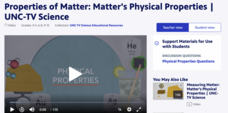Curated OER
3rd grade life science
In this life science worksheet, 3rd graders answer multiple choice questions about plants, birds, habitats, and more. Students complete 20 questions.
Curated OER
What is Matter?
For this matter worksheet, students answer 6 questions about matter. Students distinguish between homogeneous and heterogeneous mixtures, they identify elements and compounds and they distinguish between pure substances and mixtures.
Curated OER
What is the Mantle Like?
In these earth science worksheets student complete this project to model activity in the mantle, one Earth's four layers. The project includes liquid and powder materials in addition to several measuring components. Students must then...
Curated OER
Reading Comprehension Worksheet: Human Body
Practice reading comprehension with this human anatomy worksheet, which has learners first examining a 3-paragraph informational passage. The text introduces functions and features of the human heart, and 4 comprehension questions have...
Curated OER
What Should You Know about Classification?
Many learners have a tough time picking out pertinent information from a text or in class. Sometimes, all it takes is a study/reading guide to show them the way. The instructional activity here focuses on taxonomy and classification,...
Curated OER
Contour Map Worksheet #1
Being able to read a topographic map is a standard in middle school earth science units and imperative for outdoor enthusiasts. As you introduce learners to this skill, you can assign this as an assessment or reinforcement. Pupils view a...
Curated OER
What Should I Know about Respiration
How are kids supposed to know what to study for that cellular respiration test? With a study guide or reading guide like the one found here. With three pages of questions important to the understanding of respiration and the processes...
Curated OER
Half-life Worksheet
In this half-life instructional activity, students determine how long it takes for a 100g sample of AU-198 to decay to 6.25g. Then they determine the half-life of a radioactive isotope if a 500.0g sample decays to 62.5g in 24.3 hours....
Curated OER
What Should I know for the Test?
A three-page quiz about genetics, which includes Punnett squares, blood types, questions about Mendel and his contributions, and vocabulary comprehension. Use this for a study guide, a pretest/post-test, or a note-taking learning...
Curated OER
What Should I Know about Biosphere?
If your class is learning about the biosphere, you may find a study guide or reading guide helpful. Focusing on vocabulary, processes, and interactions, the Word document is easy to edit as needed to fit your needs. Another great...
Curated OER
Seasons Worksheet #2
A tilted Earth is shown in relation to the rays of light from the sun. Earth science superstars determine latitude, month, and time of day. They compare number of daylight hours for different points on Earth. The five multiple choice...
Curated OER
Contour Map Worksheet #3
Earth scientists answer five multiple choice questions about the topographical map atop the worksheet. Use this as a quick assessment of understanding after having taught how to read contour lines and topographic maps.
Curated OER
What Should I Know About Photosynthesis
This four-page handout would work great as a reading guide or note-taking resource for teens learning about ATP, photosynthesis, the key scientists in the realm of photosynthesis, and more. It is designed to accompany a certain textbook,...
Curated OER
The Greenhouse Effect
For this Earth Science worksheet, students read about the Greenhouse Effect and the difference between natural and amplified warming. Following, they answer ten short answer questions related to what they read about global climate issues.
Curated OER
Flower Dissection
For this science worksheet, students follow directions for dissecting a flower. Students tape the parts of the flower in the corresponding boxes. Students also read about how flowers reproduce and analyze a related diagram.
K12 Reader
Plant Life Cycles
Plant life cycles are the focus of a life science activity that is designed as a reading comprehension exercise. Readers respond to five questions based on the passage.
The Science Spot
Flower Basics
Learn about plants and pollination with a activity about the parts of a flower. After labeling the anatomy of a flower using a word bank, kids explain the difference between self-pollination and cross-pollination, and unscramble the...
Olathe Public Schools
Forces, Net Forces & Acceleration
Pass along the knowledge of the great Sir Isaac Newton with this activity on the laws of motion. Including three separate problems, each involving multiple parts and calculations, this resource is a great way to...
Curated OER
Imaginary Insect Zoo
In this science worksheet, students create an imaginary zoo. Students write information about their imaginary insect, including its name, how it eats, hears, seeing, smells, and eats.
PBS
Properties of Matter: Matter's Physical Properties | UNC-TV Science
Does gold really boil? Learn what temperature gold boils at and more using an animated activity about the properties of matter. Scientists learn about the properties of matter including examples of physical properties, the effect changes...
Curated OER
Basics of Science
In this basics of science worksheet, students review the metric system, the difference between homogenous and heterogenous mixtures, the scientific method, and science lab first aid. This worksheet has 15 short answer, 43 fill in the...
Curated OER
The Science of Sound
In this explanation of sound activity, students discover what sound is, how different sounds are made, frequency, how sound travels, how we hear, and a summarization. In this physical science activity, students answer ten comprehension...
Curated OER
Acids and Bases Worksheet
In this acid and base instructional activity, students solve three problems. They calculate pH and equilibrium concentrations, they determine what is needed to prepare a proper buffer solution and they answer questions about a titration.
Curated OER
Science Drawing
In this drawing in science worksheet, students read about what is needed to complete a drawing in order to communicate ideas and discoveries in science. Students analyze a drawing of a volcano and indicate the problems with the drawing....























